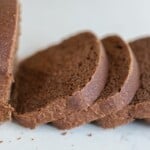
Sourdough Pumpernickel Bread
A dark, dense, and nutritious whole grain bread that boasts wonderfully unique flavors from the combination of rye flour and sourdough fermentation.
Servings 12
Calories 166kcal
Ingredients
- 1/2 cup sourdough starter: bubbly and active 113 g
- 1 1/4 cup all purpose flour 175 g
- 1 cup dark rye flour 135 g
- 1/2 cup whole wheat flour 75g
- 1 tablespoon brown sugar 13 g
- 1/4 cup molasses 70 g
- 1/4 cup cocoa powder 30 g
- 1/4 cup butter softened (56 g)
- 1/2 tablespoon salt 8 g
- 1 cup water 236 g
Instructions
- Feed your sourdough starter 4-12 hours before beginning the recipe. It should be really nice and bubbly.
- Add your active starter, flours, sugar, molasses, cocoa powder, softened butter, salt and water to the bowl of a stand mixer with a dough hook.
- Mix at low speed for 2-3 minutes until you notice the dough pulling away from the sides of the bowl into a ball. Bump up your speed and mix for another 4-5 minutes until the windowpane test is met*.
- Set the dough in a lightly oiled bowl covered with a damp tea towel, plastic wrap or a lid. A dry towel will cause the dough to dry out considerably, and we want it to stay moist.
- Place in a warm location to begin the bulk fermentation. We're looking for doubling, and this should be somewhere in the realm of 8-12 hours.
- After the first rise, roll out the dough into a rectangle on a floured surface. Shape by rolling up as a traditional loaf and pressing down the seam.
- Place seam-side down in a lightly buttered or parchment paper lined loaf pan. You can use a Dutch oven in place of a loaf pan, working your dough into a boule or round loaf.
- Again, cover your pan with a damp tea towel and let the dough rise in a warm place for 2 to 4 hours until doubled.
- With the completion of your second rise, preheat the oven to 375.
- Score the top of your loaf, if desired. This creates a beautiful crust with very little effort.
- You can add an optional egg wash at this point. Whisk together one egg with a tablespoon of water, then brush it over the top of the loaf.
- Bake for 35 to 40 minutes, cooling completely before slicing.
Notes
- *Check for proper gluten development by using the windowpane test. Take a small piece of dough and pull it apart in a rectangular shape, checking if the center is stretching to a thin, see-through "windowpane" where light can be be seen through it, or if it simply tears or breaks apart. Tearing too easily indicates the gluten needs more time to develop. If this is the case, continue mixing another few minutes.
- Rye flours can quickly become confusing. They can come as white, medium, and dark, with varying levels of textures and nutrition depending on what parts of the grain are left intact. Dark rye flour generally includes the greatest portion, if not all, of the grain (bran, endosperm, and germ), providing a bolder flavor and higher nutrition. This is what sets pumpernickel apart and what you'll want to look for.
- If you have a grain mill, you can also grind whole rye berries to make your own rye flour.
- Sourdough bread made with rye flour tends to be a pretty sticky dough. This is due to rye having less gluten-forming protein than wheat flours. You won't want to add additional flour for risk of a dry loaf of bread, but working on a well-floured surface with floured hands should help, using a bench scraper as needed.
Nutrition
Calories: 166kcal | Carbohydrates: 29g | Protein: 4g | Fat: 4g | Saturated Fat: 3g | Polyunsaturated Fat: 0.3g | Monounsaturated Fat: 1g | Trans Fat: 0.2g | Cholesterol: 10mg | Sodium: 326mg | Potassium: 196mg | Fiber: 3g | Sugar: 6g | Vitamin A: 119IU | Calcium: 25mg | Iron: 2mg